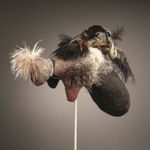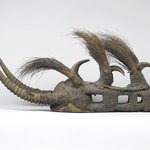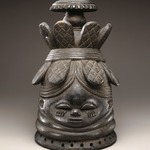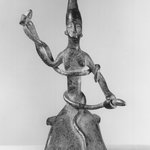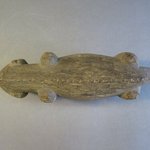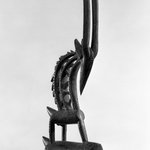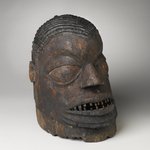
Headdress (Ci-wara Kun)
Arts of Africa
In developing the costumes in her installation displayed here, Saya Woolfalk drew from hybrid animal masks such as this ci-wara headdress. Worn on the heads of male dancers, ci-wara headdresses are danced in pairs, often male and female, to symbolize the fertility of land and animals. Each headdress represents a composite of animals, such as antelopes or pangolins (strong, clawed mammals with a protective armor), that are metaphors for the successful farmer who tirelessly and efficiently tills his fields.
CULTURE
Bamana
MEDIUM
Wood, metal, pigment
DATES
20th century
DIMENSIONS
11 x 22 1/4 x 2 1/2in. (27.9 x 56.5 x 6.4cm)
(show scale)



COLLECTIONS
Arts of Africa
ACCESSION NUMBER
1989.51.51
CREDIT LINE
The Adolph and Esther D. Gottlieb Collection
CATALOGUE DESCRIPTION
Shiny black patina. Elongated head and neck; sidesfg curved horns incised with herringbone pattern extend from head with ears in front; metal band encircles right horn near tip. Metal tacks for eyes, mouth slightly open with tongue depicted. Band of metal sheeting encircles middle portion of neck, raised metal patterning. Foreshortened body, slightly raised toward back of figure, with tail coiling back on itself at tip. Male genitalia. Short fore- and rear legs, bent, continue into oval platform with four holes used for securing figure to top of head.
EXHIBITIONS
MUSEUM LOCATION
This item is not on view
CAPTION
Bamana. Headdress (Ci-wara Kun), 20th century. Wood, metal, pigment, 11 x 22 1/4 x 2 1/2in. (27.9 x 56.5 x 6.4cm). Brooklyn Museum, The Adolph and Esther D. Gottlieb Collection, 1989.51.51. Creative Commons-BY (Photo: Brooklyn Museum, 1989.51.51_SL3.jpg)
IMAGE
threequarter, 1989.51.51_SL3.jpg. Brooklyn Museum photograph
"CUR" at the beginning of an image file name means that the image was created by a curatorial staff member. These study images may be digital point-and-shoot photographs, when we don\'t yet have high-quality studio photography, or they may be scans of older negatives, slides, or photographic prints, providing historical documentation of the object.
RIGHTS STATEMENT
Creative Commons-BY
You may download and use Brooklyn Museum images of this three-dimensional work in accordance with a Creative Commons license. Fair use, as understood under the United States Copyright Act, may also apply.
Please include caption information from this page and credit the Brooklyn Museum. If you need a high resolution file, please fill out our online application form (charges apply).
For further information about copyright, we recommend resources at the United States Library of Congress, Cornell University, Copyright and Cultural Institutions: Guidelines for U.S. Libraries, Archives, and Museums, and Copyright Watch.
For more information about the Museum's rights project, including how rights types are assigned, please see our blog posts on copyright.
If you have any information regarding this work and rights to it, please contact copyright@brooklynmuseum.org.
RECORD COMPLETENESS
Not every record you will find here is complete. More information is available for some works than for others, and some entries have been updated more recently. Records are frequently reviewed and revised, and we welcome any additional information you might have.












